The new baseball season has begun and I got to attend my first ever opening day game. By the way the Phillies defeated the Oakland Athletics by a score of 9 to 5. That kind of score should be typical of Phillies games this season as team looks to score a lot of runs but their pitching is kinda suspect.

One of the best things about the sport of baseball is that with the action so spread out it makes it easy to follow all of the physics that’s happening down on the field. Whether it be the trajectory of a home run or a line drive up the middle, hey even just a broken bat ground out to shortstop it’s all physics.
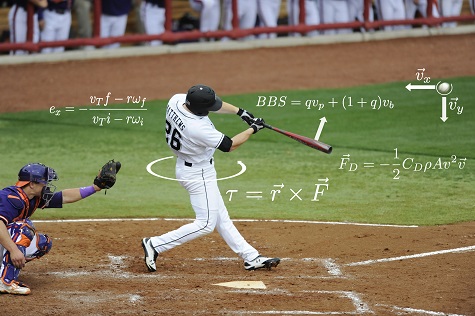
Of course some of the most interesting physics comes as the pitcher prepares to throw the ball to his catcher hoping that the batter will either swing at it and miss or at least hit the ball so weakly that one of the fielders can make a play and get an out. In order to accomplish this pitchers try to deceive the batter about the kind of pitch that’s coming. And pitchers have a wide variety of pitches that they can throw including fastballs, sinkers and curveballs as well as the infamous knuckleball along with variations on those pitches.
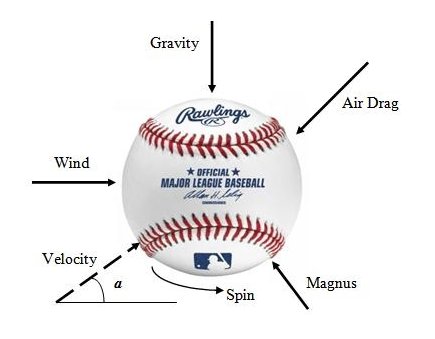
Now simple trajectories, like that home run, are often discussed in freshmen physics classes by ignoring the effect of wind resistance, not a bad approximation if the wind isn’t blowing too hard. The motions that pitchers can put on a ball however cannot be approximated in that way however because they are all due to the interaction between the ball and the air molecules through which it moves. And the most important factor in determining how the trajectory of a pitch deviates from a trajectory without air is the direction and orientation of the spin that the pitcher puts on the ball as he releases it.
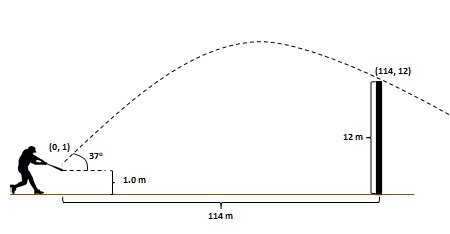
Everybody knows that spin has two distinct directions, sometimes called clockwise and counter-clockwise or right handed and left handed. For a ball traveling more or less horizontally and whose axis of spin is both horizontal to the ground and perpendicular to the direction in which the ball is traveling those spin directions can be referred to as top-spin, where the top of the ball is rotating in the direction that the ball is traveling, and back-spin, where the bottom of the ball is rotating in the direction that the ball is moving. See diagrams below. Later on we will consider what happens when that axis of spin is not horizontal and perpendicular to the balls motion.
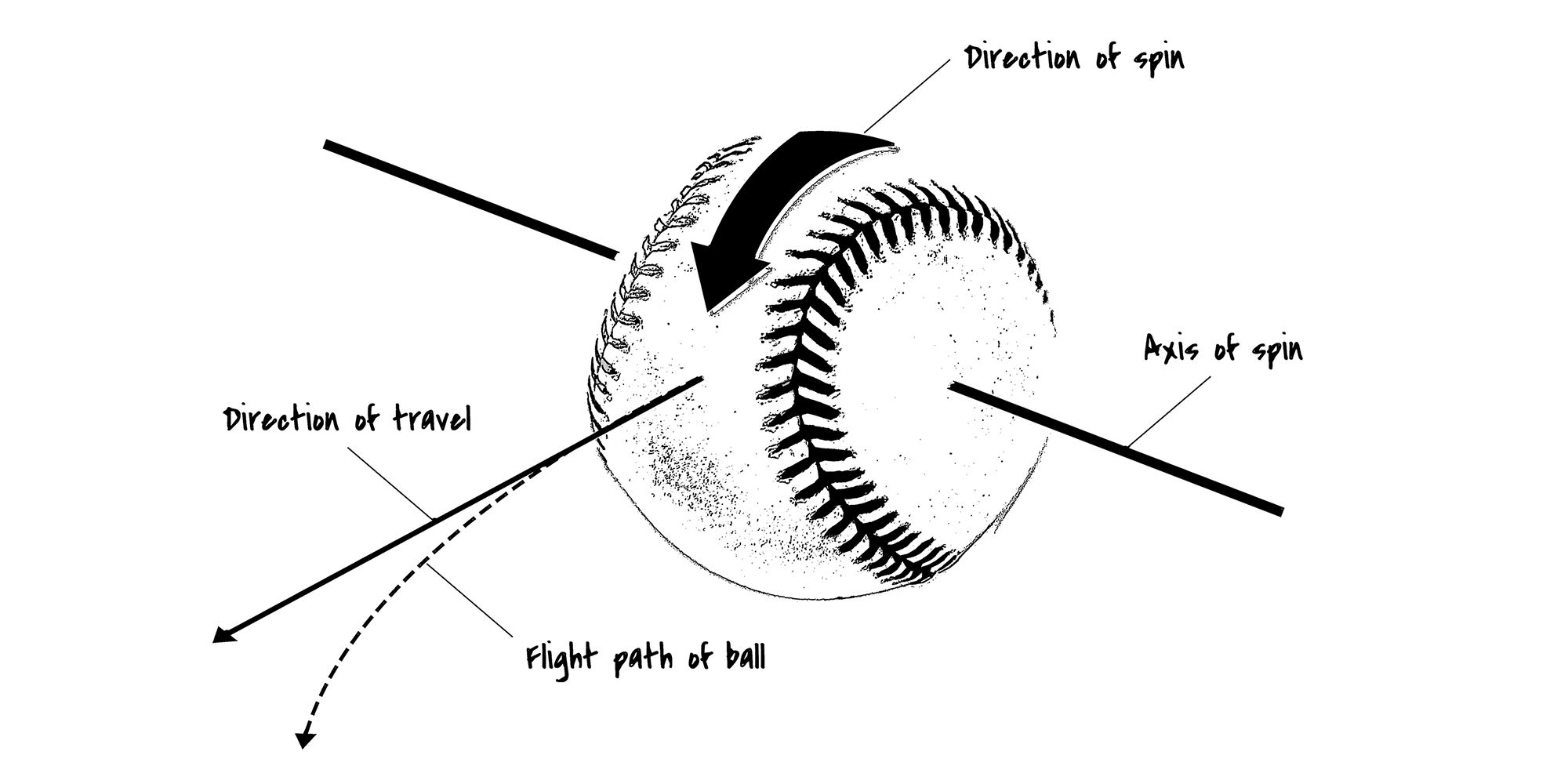

That spin on the ball as it moves through the air generates a difference is pressure on the top and bottom of the ball causing a force on the ball due to what is known as the Magnus effect. In the Magnus effect the side of the ball moving in the direction of travel has the greater pressure and so the is pushed the other way. This means that topspin produces a downward force causing the ball to drop faster than it would in a vacuum. This sort of pitch is known as the sinker because it does just that, dropping faster than the batter anticipates causing him to either miss it entirely or hit a weak ground ball somewhere.

Backspin does exactly the opposite, generating an upward force so that the ball seems to rise, hence a rising fastball. In actuality however the ball is still dropping due to gravity but it doesn’t drop as fast as it would in a vacuum. In this case the intent is to make the batter either miss the pitch or get under it, popping the ball up so that a fielder can catch it for an out.
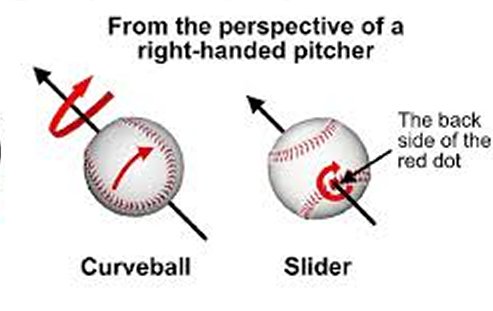
Back in the late 1950s a physicist at the National Bureau of Standards named Lyman J. Briggs undertook a study of the way in which the Magnus effect could change the trajectory of a baseball under typical game conditions. What he found was that the change in position when the ball arrives at the plate was proportional to the amount of spin the pitcher had put on the ball and proportional to the square of the ball’s horizontal speed. For pitch speeds of 70 to 100 miles per hour and spins of 20-30 rpm the change in position would range from between 10.8 to 17.5 inches. (Yes I know, I’m using Imperial units, please forgive me but this is baseball where the bases are 90 feet apart, the distance from the pitching rubber to home plate is 60 feet 6 inches and a baseball weighs between 5 and 5.25 ounces.)

O’k, so we’ve discussed the sinker and rising fastball, pitches that seem to go either down or up depending on the spin, but what about pitches that move sideways like the curveball or screwball. Well you remember I assumed above that the axis of rotation of the ball was horizontal and perpendicular to the direction that the ball is moving. What if we remove that constraint and allow a righthanded pitcher to rotate the spin axis about 45º clockwise? In that case the Magnus effect will cause the ball to move laterally to the left, a standard curveball. For a lefthanded pitcher the curveball is produced by rotating the spin axis about 45º counterclockwise and the ball will move laterally to the right.

And when a righthanded pitcher rotates the spin axis of the ball counterclockwise, so that it moves to the right or a lefthanded pitcher rotates the spin axis clockwise to make it move left you get a screwball. The reason the pitch is known as a screwball it is so rarely seen that its motion seems really weird, and the reason its so rarely seen is that its so dammed hard to throw.

We’ve covered most of the standard, best known pitches but I’ll finish off today with the pitch that every batter, and most pitchers really hate, the knuckleball. The essence of the knuckleball is that the pitcher does his best to put no spin on the ball, eliminating any contribution to the motion of the ball due to the Magnus effect.

That way, as the ball moves toward the plate it gets pushed about by every little breeze, every little pocket of turbulence. A well thrown knuckleball floats and darts this way and that so that neither the batter, nor the pitcher knows where it’s going to end up. A poorly thrown knuckleball does nothing, making it an easy target for the batter to drive out of the park. So as we begin another season of our national pastime it’s worth remembering how baseball is really all about the physics!
